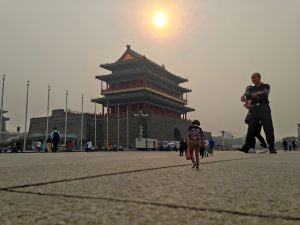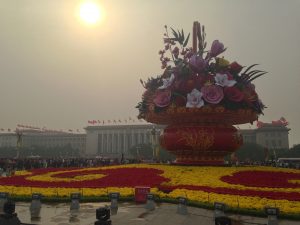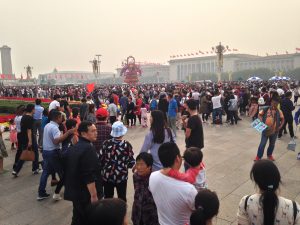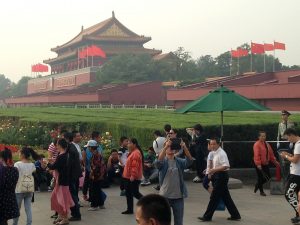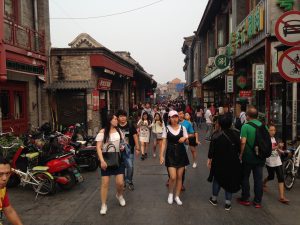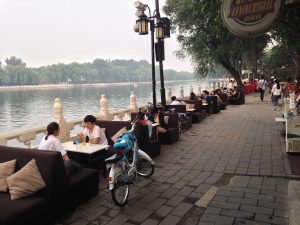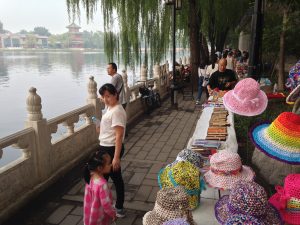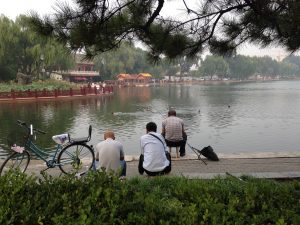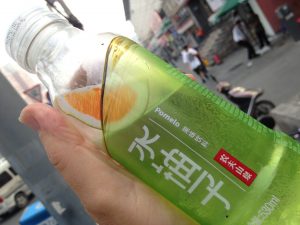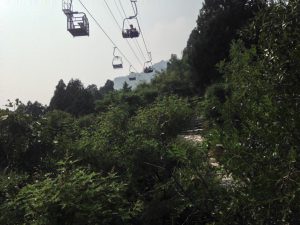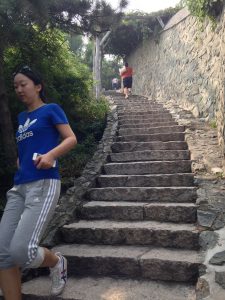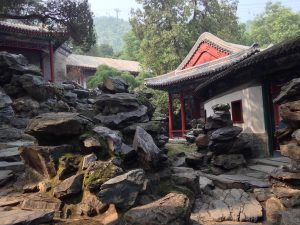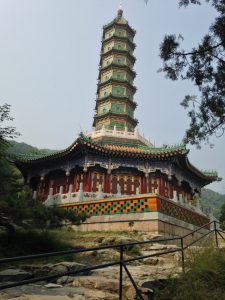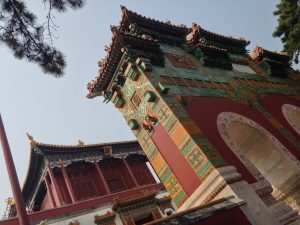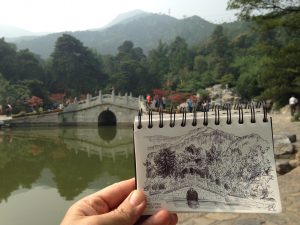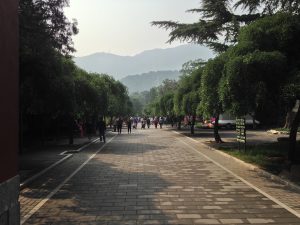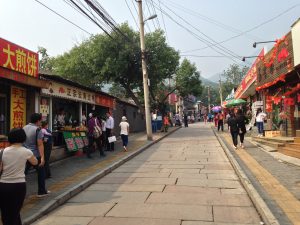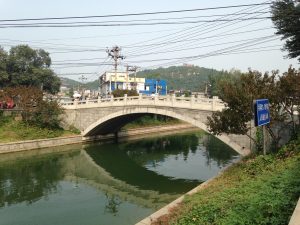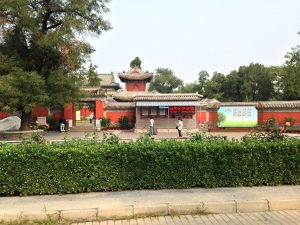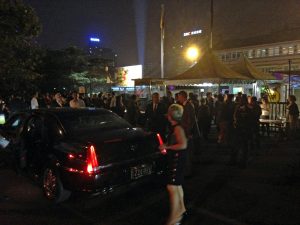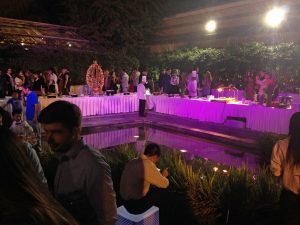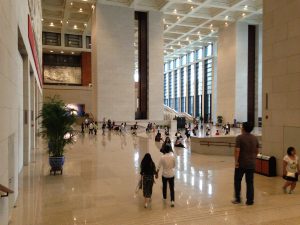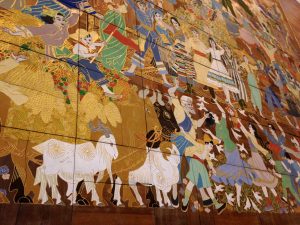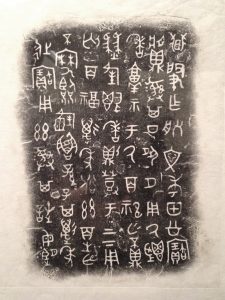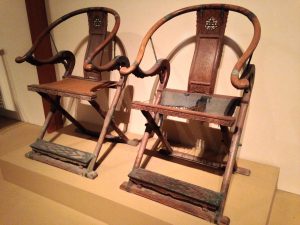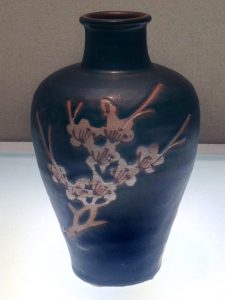Am Freitag, dem Vorabend der Nationalfeiertage – auf den Straßen, im Verkehr, im Supermarkt überall geschäftiges Treiben. Das Internet ist so lagsam wie bisher hier noch nicht erlebt. Es wird sicherlich daran liegen, dass alle Chinesen sich jetzt noch mal schnell per WeChat verständigen darüber, was noch eingekauft werden soll – sie bezahlen sogar per WeChat. Der QR-Code wird an der Kasse einfach gescannt und dann vom Konto direkt abgebucht. Sie benutzen die App – ähnlich wie wir WhatsApp – für die komplette mobile Kommunikation – zumindest dort wo sie Internet-Empfang haben.
Die Volksrepublik China wurde nach dem Sieg der Kommunisten im Chinesischen Bürgerkrieg am 1. Oktober 1949 gegründet (mehr dazu bei ChinaTravelGuide). In diesem Jahr fällt dieses Datum auf einem Sonnabend – arbeitgeberfreundlich! Am Dienstag sind die offiziellen drei Nationalfeiertage vorüber. Die meisten Betriebe geben ihren Mitarbeitern jedoch insgesamt eine ganze Woche frei. Allerdings ist diese Regelung inzwischen freiwillig. In manchen Firmen wird auch ab Dienstag wieder voll gerabeitet und das kommende Wochenende noch dazu genommen, um versäumte Arbeitszeit nachzuholen.

Als ich mein Apartment am Sonnabend gegen 11 Uhr verließ, waren auf der Straße nur wenig Leute unterwegs. Die Sonne schien mild auf ein insgesamt sehr heitere Feiertagsstimmung. Am frühen Nachmittag ging ich zusammen mit meinem Sohn auf der Changan westwärts zum Platz des Himmlischen Friedens, in der Hoffnung dort noch irgendwelche Paraden zu sehen. Ab der Wanfuqing trafen wir auf sehr dichtes Treiben. Um den gesamten Platz herum sind Sicherheitskontrollen eingerichtet, die heute jedoch wegen des starken Andrangs relativ lax gehandhabt wurden.
Der Platz des Himmlischen Friedens (Tiananmen) ist ca. 40 Hektar groß und damit die größte zusammenhängend befestigte Fläche weltweit. Auf ihm können sich bis zu 1 Million Menschen versammeln. Ganz so viele waren es heute mit Sicherheit nicht; jedoch bekommt man schon einen gewissen Eindruck davon, wenn dort nur einige zigtausend Chinesen in Feiertagsstimmung unterwegs sind, mit ihren kleinen roten Fahnen wedeln und Selfies machen.
Am Freitag ist die „Golden Week“ vorüber. Viele Chinesen nutzen diesen einwöchigen Kurzurlaub für Ausflüge zu Sehenswürdigkeiten und den Besuch ihrer Familien im ganzen Land. Dank gestiegener Einkommen können sich die meisten dies heute leisten. Eine geschätzte halbe Milliarde Chinesen ist unterwegs. Axel Dorloff, ARD-Hörfunkstudio Peking spricht von der „größten Völkerwanderung der Welt“.
Zweifelhafte Verlockungen
Schon bei meinem ersten Abendspaziergang vor zwei Wochen wurde ich an einer Ecke der Wangfuqing – der klassischen Shoppingstraße Pekings – von einer Dame mittleren Alters angesprochen, ob ich „Massage“ haben wolle. Auf dem Weg zu meinem Apartment wurde ich dann an den Treppen des Oriental Plaza nochmals angesprochen: „You want lady for your room?“ Vor 25 Jahren undenkbar. Dass das Lustgewerbe hier inzwischen breit aufgestellt ist, kann man schon auf der Straße sehen. Allein in meinem Wohnblock gibt es zwei SPAs, die mit Fuß- und Ölmassagen werben. Heute morgen fand ich dann direkt an der Tür meines Aparments eine kleine bunte Werbung – nur halb so groß wie eine Visitenkarte. Beidseitig bedruckt mit den verlockenden Bildern zweier nur notdürftig verhüllter weiblicher chinesischer Körper – mit Telefonnummer, die ich allerdings hier auf dem Bild ausgeblendet habe.
What the bug?
Interesting animal I found on the footwalk yesterday during my lunch break near Ritan Park in Beijing. About 40 mm long with beautiful decorative black dot pattern on the pale semitransparent forewings with a sharp warm red shining through from the underlying hindwings. I sent my photo to insect expert Dave Goulson who replied immediately but not being able to give a clue beyond this: Leafhopper in the family of Hemiptera. In Wikipedia I found out that there are more than 12,000 species in this insect family. As I found out it must be someone in the species of Auchenorrhyncha, either Fulgoromorpha or Cicadomorpha.
Cicadas are very noisy during summer. But as autumn arrived yesterday, with strong northwest winds from the dessert (only 13°C at night) I believe that their lifetime is coming to an end. The Chinese are very fond of cicadas as you can see in an Baidu image search on cicadas .
One day later – again on my midday stroll – I found further specimen lying under a black locust tree (Robinia pseudoacacia) – all smaller than my „beast“, all dead, some already tramplet on.
Does anyone reading this article can give more clues on this beast? It would be very much cherished!
Fragrant Hills and back
Early saturday morning, heading with my bicyle for the famous park northwest of Beijing. I need to leave the urban surroundings at least once a week. The weather ist fine. In the cool mornig air I choose a route from my apartment strait north following the Ritan Street. After reaching almost the 3rd ring road I find a sign for public toilet. The doorman of a public school kindly shows me the way. The toilet room is unexpectantly clean. On my way back the nice doorman offers me a cigarette and wants to chat in Chinese about German footballl and Syrian refugees. Later his wife joins us. With the help of my Pleco dictionary I find most of the words. My Chinese is still underdeveloped.

Following 3rd ring until Haidian district, then turning north passing the university area. The sun is getting more intense now. It is almost ten o’clock. Riding westwards I recognize the Old Summer Palace (Yuan Ming Park) to my right. Soon after the car traffic gets very dense in the roads surrounding the Summer Palace. It is the big touristic attraction in these early autumn days. I find a small bridge on the north east corner of the area to cross, finding my way to Xiang Shan Road. It is still another six-seven kilometers to ride.
About half way I pass the Beijing Botanical Garden. It does not seem so interesting with its rather modern Chinese interpretaton of garden architecture and colour combinations regarding the flowers arrangements. When entering the small city beneath the Xiang Shan (Fragrant Hill) Park I realize having been here before, more than twenty years ago. Driving up the old main road, plastered with huge stone plates memories are recalled. Lots of touristic shops and small restaurants on both sides. The only problem I have, is finding a decent place to park my bicylcle. I am sure that they take money for that as well!
After not being successful in the car parking lot: A lady with sunglasses and mouth-cover just shaking her head when I ask if it is okay to lock my bike to the metal fence. Further down a side road I might be more lucky. When just about to park my bike next to a motorcyle I am surrounded by neighbours eagerly discussing the matter. One lady wants me to take the bike away, whereas an old man insists that it is quite okay to leave the bike next to the wall. Another old lady laughts and says something about taking five Renminbi (local currency) for that service. I laugh and make my way up to the entrance of the park. Hoping to find my bicyle all right when I return …
Even I took a snapshot of a park map, I would not realize which is which site, because on the map all names are in Chinese (tourist map of Fragrant Hills Park in English). So I just walk about reaching a pond with a beautiful bridge, giving an excellent, almost panoramic view on the scenery including the more remote hills. I settle to capture the landscape in my sketchbook using a black ballpoint pen. Later I will do a watercolour based on my photo reference. I am just starting to get into drawing and painting again. It is quite hot sitting in the midday sun. Once in a while someone stops to look over my sholuder an comment on work in progress. Not molesting, always very positive and respecting.

I drink too little. Not that I am miserly about buying water. It is just, that I forget to drink. But I nibble on some grapes and small delicious pears. A bit higher up I find first a palace and then even higher the tall pagoda. Somewhere in the woods I hear a female voice singing Chinese traditional songs. I try to get closer following a small footpath through the bushes but fail because the track is getting too steep, clayey and narrow. Later I find myself in a temple – its is all temples here – with a big pond full of Koi carps being fed by both young and old.

Finally I decide to climb the hill top. Most people take the cable car. This seems to be quite adequate in the hot weather – I believe it is not less than 26°C. The stone steps are steep. Even the people descending are sweat and breathless. I try to keep pace with a sporty man in his thirties. He is bare breasted while I carry a backpack. I manage to keep his speed for quarter of an hour. Then I have to rest. Magnificent views. After more than half an hour I finally reach the top with the cable car station. I am completely overheated and soaked with sweat. The cool breeze comforts me. After taking only a short rest enjoying the overall views I make my way down again. There are numerous paths all leading towards the valley and then to one of the gates.

Riding almost six hours on my bicycle, covering almost 60 kilometers, climbing around in the park for more than three hours including reaching the almost 500 meter peak – I am more than happy to arrive safely in my apartment, take a shower, rest and digest the input …

Tag der Deutschen Einheit
Ungewöhnlich, diesen Tag bereits am 22. September zu begehen. Grund hierfür ist ein Konflikt der Nationalfeiertage: China hat die gesamte erste Oktoberwoche nationale Feiertage – Grund genug für die deutsche Botschaft in Peking jetzt schon zu feiern. Eine gute Freundin, die an der deutschen Botschaftsschule arbeitet, lud mich kurzfristig ein. Alle die einen deutschen Pass besitzen sind herzlich willkommen. Als ich gegen 19 Uhr mit dem Fahrrad an der Dongzhimenwaidajie No. 17 ankomme, erwartet mich eine lange Schlange von Wartenden. Ich gehe nach vorne zum Eingangsbereich. Langsam darf das gewöhnliche Volk auf das Gelände. Gerade wird der amerikanische Botschafter verabschiedet und zu seiner Staatskarosse begleitet. Geladene Gäste waren schon vorher willkommen geheißen.
Jetzt geht es zügig voran. Die Freundin taucht plötzlich auf und reiht sich bei mir in die Schlange ein. Hinter uns ihre Schülerinnen – welch Zufall: auch Peking ist eine kleine Welt! Es folgt eine sehr oberflächliche Kontrolle meines Rucksacks: Weder Taschenmesser noch Fahrradwerkzeug wird gefunden. Der Rummel auf dem Botschaftsgelände ist eine Mischung aus lockerem Empfang und Oktoberfest. Dieses Jahr wird an alle – nicht nur die geladenen Gäste – Sekt ausgeschenkt, nachdem man sich an den Gepflogenheiten der französischen Botschaft orientiert hat, so sagte man mir. Wohl fast tausend Gäste unterschiedlichster Couleur vergnügen sich bei deutscher Gastlichkeit auf dem weitläufigen Gelände. Ich bin immer wieder erstaunt darüber, dass mir deutsches Essen im Ausland nicht wirklich schmeckt. Genau das Gleiche erlebe ich mit chinesischem Essen in Deutschland. Scheint ein olfaktorisches Phänomen zu sein.
In der Runde befreundeter Lehrerinnen und Lehrer der Botschaftsschule erste Gespräche über die Wahrnehmung des Landes und der Menschen. Einige sind erst seit wenigen Wochen hier, andere bereits seit mehr als 10 Jahren. Aber überall die gleiche positive Grundhaltung zu dem Leben in Peking. Egal ob um es politische, wirtschaftliche oder soziale Aspekte geht oder nur um den vermeintlich chaotischen Verkehr: Die meisten stehen begeistert bis ehrfürchtig vor dem „Chinesischen Wunder“ dessen Früchte sie in vollen Zügen genießen. Das Bild, das die deutschen Medien von China prägen, ist für das Selbstbild des gesättigten Deutschen zurechtgemacht: Populistischer Mainstream-Journalismus. In einem Gespräch habe ich die Idee des „Moulüe“ angerissen. Darunter versteht man ein Konzept der Supraplanung, das erklärt, warum wir von den Chinesen immer nur das kleinteilige Funktionieren und Reagieren wahrnehmen, jedoch nicht den großen Plan, der über Jahrhunderte reicht.
Nachdem die Getränke anfingen auszugehen, machte ich mich – noch vor dem großen Gewitter auf den Weg zu meinem Apartment. Ich bedanke mich bei der deutschen Botschaft – und dem deutschen Steuerzahler – für einen unvergesslichen Abend mit tiefen Einblicken ist das Leben deutscher „Expatriats“, das ich gut vergleichen kann mit dem, was und wie meine Eltern hier vor einem Vierteljahrhundert erlebt haben.
Einige Eindrücke vom Abend …
Selbst ist der Mann
Heute habe ich zum überhaupt ersten Mal in China selbst gekocht! Seit einem Vierteljahrhundert besuche ich nun das Land – ohne auch nur ein einziges Mal in der Küche gestanden zu haben. Auch die vergangene Woche war ich oft auswärts essen, meist zu Firmenessen eingeladen. Gestern abend dann ein erster mutiger Versuch: Eine scharfe Nudelsuppe mit Rindfleisch in einem muslimischen Restaurant – bestellt mit „Finger auf buntes Bild zeigen“. An anderen Abenden gab es nur Snacks auf dem Zimmer …
Nachdem ich mich in den vergangenen Tagen mit der nötigsten Küchenausrüstung versorgt hatte, heute nun Besuch der Gemüseabteilung im Supermarkt „Happiness Mart“. Bei Auswahl und Preisen kann man dann auch wirklich nur glücklich werden: Die Zutaten für alle Gerichte kosteten zusammen weniger als zwei Euro! Es gab Auberginen und Austernpilze, separat im Wok geschmort, mit Knoblauch, Ingwer, Sojasoße und weißem Essig abgeschmeckt.
Es gab Auberginen und Austernpilze, separat im Wok geschmort, mit Knoblauch, Ingwer, Sojasoße und weißem Essig abgeschmeckt.
Daneben einen Gurkensalat mit chinesischem Limettenaft sowie einige Schnitten einer Art gewürztem Fladenbrots. Zu trinken Eisbier von Harbin – aus dem Norden des Landes und einen lokalen Hirseschnaps.
An Afternoon at the Museum
My Chinese colleague urged me to do some sightseeing during the moon festival. So – since none of us had been there before – we decided to visit The National Museum next to Tiananmen Square an saturday. When surfacing from the subway station we had to cue first at a security checkpoint where both us and our baggage was scrutinized. Lighters were taken away from people. Some time ago terrorists had set off a bomb on the Square of Heavenly Peace. There is no admission fee for entering the museum but foreign visitors have to show their passport at a special office.
Entering the museum is quite an experience if you are not familiar with Chinese prestige architecture: The hall is huge with vast flights in all directions. After looking at the bold Dalí sculptures on the ground floor we decided to briefly have a look at some of the Chinese permanent exhibitions: bone scriptures, wooden furniture and last but not least the most remarkable show of gifts presented by official visitors to the People of China.
One of the most impressive present Richard Nixon presented when initiating normalization talks with Mao Zedong in 1972: A pair of swans made of porcelain molded by an US american artist. Only a pity that most of the Chinese traditional exhibits did not have any English descriptions.
Have a look at some of the exhibits in the gallery below. Click on images to view enlarged
Running through the past
After the short thunderstorm last night the morning was sunny with a hint of blue skies. I put on my running gear and left my apartment just past 7 a.m. heading directly north through the old diplomatic quarter entering Ritan-Park. Many Chinese were already out practicing all sorts of sports like batminton, Tai Qi and dance. Leaving the park through the north gate I turned left and followed Ritan Street heading north passing one of the Russian quarters of Beijing. Only few people were in the streets, hardly any cars. Some garbage men were collecting waste emptying their electric driven container vehicles into larger waste container lorries. At a parking lot the drivers of courier tricycles where sorting out packages to be delivered spreading them all over the place.
At Gongrentiyuchang North Road I turned right leaving the Workers Gymnasium and the Workers Stadium at my right hand side. My left heel was already getting sore. Originally intending to take all the way to Chaoyang Park I suddenly realized the Sanlitun area just north of me. A lot had changed since I first dwelled in this place quarter of a century ago. The place had been through a severe process of gentrification since. The old one storie houses and narrow streets have been replaced by and partially even combined with very modern experimental architecture. Already in the 1990ies it was „en vogue“ with bars, clubs and fashion outlets. now it has become an institution with flagship stores of major international lifestyle brands.
Further north small housing units have survived. Making my way through the narrow alleys arriving at Dongzhimen Outer Street then turning left heading towards the center. Here I recognize a lot of places: Paddy O’Shea – the Irish Pub dates already back to the 1980ies. Also the beautiful Donghu Apartments with The Pizza Hut below. Lots of memories entered my mind. My parents lived there for two years in the beginning of the 1990ies.
On the way back the sun is getting more intense. Following Chunxiu Street southwards I almost picked the same route – just opposite direction – arriving at my apartment around nine o’clock.

In der Fremde
Habe jetzt die Bestätigung des Gerüchts, dass Google und Facebook tatsächlich nicht funktionieren. Zumindest nicht auf der langsamen Leitung im WLAN meines Zimmers. Heute ist ein diesig-smogiger Septembertag; keine 300 Meter Sicht. Die Stadt hat sich seit meinem letzten Aufenthalt 2008 an vielen Orten verändert. Allerdings ist im Bereich Jiaenguomenwai doch noch Vieles beim Alten. Die Büros meines Partners liegen im CITIC Gebäude, einem der ältesten modernen Bürogebäude der Stadt. Ich erinnere mich bereits 1991 bei meinem ersten Besuch dieses kupferfarbene Hochhaus im Zentrum der Stadt bewundert zu haben.


19 Jianguomenwai Avenue
erbaut 1985-1986
101 m hoch, Stockwerke
China … here I come!
In diesem Blog werde ich ab dem 12. September 2016 die Eindrücke meines Aufenthaltes in China festhalten: in Texten und Bildern.




